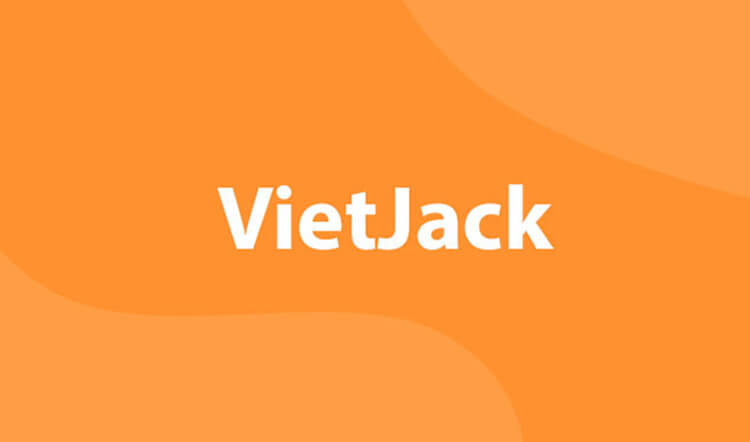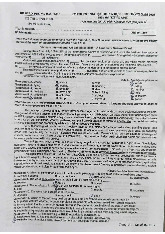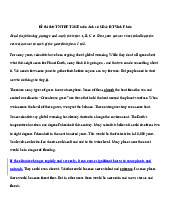




Preview text:
SỞ GDĐT BẮC NINH
ĐỀ THI THỬ TỐT NGHIỆP LẦN 1
TRƯỜNG THPT THUẬN THÀNH SỐ 1, NĂM HỌC 2024 - 2025 SỐ 2 MÔN: Tiếng Anh --------------------
Thời gian làm bài: 50 phút
(Đề thi có 4 trang)
(không kể thời gian phát đề)
Họ và tên: ............................................................................ Số báo danh: ....... Mã đề 512
Read the following leaflet and mark the letter A, B, C or D on your answer sheet to indicate the option
that bestfits each of the numbered blanks from 1 to 6.
Practical Tips to Reduce Waste at Home
Making small changes at home can make a big difference. Here are some effective actions you can take:
• Use reusable items instead of disposable ones to reduce (1) _____ waste produced each year.
• Save water by fixing leaks and installing water-efficient fixtures. This action helps (2) _____ the
consumption of valuable resources and reduces your water bill.
• Sort your recyclables like plastic, metal, and paper. Proper sorting makes (3) _____ easier and helps prevent waste.
• (4) _____ using plastic bags, choose a reusable bag that lasts longer and is eco-friendly.
• Buy local products with minimal packaging. Supporting local goods reduces the need for long-distance
(5) _____, which lowers emissions and benefits the environment.
• Compost food scraps if possible, as this process transforms organic waste into (6) _____ soil, useful for plants and gardens.
Question 1. A. much B. some C. every D. many
Question 2. A. put up with B. hold back C. run out of D. cut down on
Question 3. A. collection B. storage C. conservation D. recycling
Question 4. A. Even if B. However C. Instead of D. Although
Question 5. A. development B. travel C. transport D. connection
Question 6. A. healthy B. fertile C. abundant D. various
Read the following passage and mark the letter A, B, C or D on your answer sheet to indicate the best
answer to each of the following questions from 7 to 14.
In the modern era, social media has become deeply ingrained in the daily routines of millions of
teenagers worldwide. Platforms like Instagram, TikTok, Facebook, and Snapchat provide young people
with the ability to stay connected with their friends, share their daily experiences, and express themselves
in ways that were not possible just a few decades ago. Social media also offers opportunities for teenagers
to showcase their creativity through content creation, whether it be posting photos, videos, or written
content. However, it is important to recognize that it also comes with certain drawbacks, particularly concerning mental health.
On the positive side, social media has made it easier for teenagers to maintain relationships,
regardless of geographical distance. It allows them to participate in online communities, discuss topics
they are passionate about, and find individuals with similar interests. Furthermore, social media has
emerged as an educational tool, with many teens using it to follow educational influencers or access
online tutorials to enhance their learning.
However, this constant connectivity comes at a cost. The pressure to present a flawless image on
social media has caused many young people to feel inadequate, comparing themselves to the highly
curated, often unrealistic portrayals of others' lives. This comparison culture can lead to anxiety,
depression, and a distorted sense of self-worth. Additionally, excessive use of social media has been
linked to addictive behaviors, negatively affecting mental health and academic performance.
Teenagers may spend hours scrolling through their feeds, neglecting their responsibilities or losing
sleep due to late-night browsing. Over time, this can negatively impact their academic performance and
overall well-being. Despite these challenges, social media remains an integral part of teenage life, and it is
crucial for parents, educators, and teenagers themselves to understand both the benefits and risks.
Question 7. In which paragraph does the writer discuss the addictive nature of social media? A. Paragraph 1 B. Paragraph 3 C. Paragraph 2 D. Paragraph 4
Question 8. Which of the following is TRUE according to the passage?
A. Teenagers use social media less for education and more for relaxation.
B. Social media is essential for all teenagers' education.
C. The pressure to maintain online friendships reduces mental stress.
D. Social media can cause feelings of inadequacy and comparison.
Question 9. Which of the following is NOT mentioned as a positive effect of social media on teenagers?
A. Keeping in touch with the friends
B. Helping with many academic studies
C. Encouraging people’s creativity
D. Providing opportunities for relaxation
Question 10. The word "express" in paragraph 1 could be best replaced by______. A. suppress B. hide C. deny D. communicate
Question 11. The word "this" in paragraph 4 refers to______.
A. Staying up late browsing
B. Ignoring responsibilities
C. Excessive social media use and sleep
D. Neglecting duties and losing sleep
Question 12. The word "inadequate" in paragraph 3 is OPPOSITE in meaning to______. A. sufficient B. unsuitable C. confident D. limited
Question 13. In which paragraph does the writer mention the benefits of social media for educational purposes? A. Paragraph 2 B. Paragraph 3 C. Paragraph 4 D. Paragraph 1
Question 14. Which of the following best paraphrases the underlined sentence in paragraph 3?
Additionally, excessive use of social media has been linked to addictive behaviors, negatively
affecting mental health and academic performance
A. Excessive use of social media can result in addiction, but it does not affect academic performance.
B. Spending too much time on social media can lead to addiction, harming both mental health and school performance.
C. Social media addiction has been shown to improve academic performance despite its negative impact on mental health.
D. Using social media too much only affects mental health, with no link to academic performance.
Read the following advertisment and mark the letter A, B, C and D on your answer sheer to indicate
the option that best fit each of the numbered blanks from 15 to 20.
Fit & Active Gym Membership
Are you looking for a place to work out that is open 24/7? Fit & Active Gym welcomes all fitness
levels in a (15) _____ environment. Our gym provides (16) _____ equipment and a variety of classes,
including weightlifting, yoga, and cardio. We have the perfect programs for all of you.
Become a member for only $35 a month and enjoy a supportive community of fitness enthusiasts. You
can also download our app (17) _____ you to track your progress, set goals, and (18) _____ connected
with other members online. Our personal trainers are here to help you achieve your fitness goals and stay motivated.
Start your journey toward a healthier you (19) _____ Fit & Active Gym—where fitness meets
convenience! Join today and (20) _____ your first month free!
Question 15. A. supportive B. support C. supported D. supportedly Question 16.
A. high-quality Japanese new
B. new Japanese high-quality
C. Japanese high-quality new
D. high-quality new Japanese
Question 17. A. is allowed B. allowing C. allowed D. that allow
Question 18. A. keep B. play C. stay D. make
Question 19. A. to B. with C. at D. by
Question 20. A. received B. receive C. receiving D. to receive
Mark the letter A, B, C or D on your answer sheet to indicate the best arrangement of utterances or
sentences to make a meaningful exchange or text in each of the following questions from 21 to 25.
Question 21. a. Over the past few years, I’ve journeyed to various parts of the world, from the bustling
streets of Tokyo to the serene beaches of Bali.
b. My love for adventure and curiosity about different ways of life has fueled my desire to explore,
making each trip more rewarding than the last.
c. Traveling to new countries and experiencing diverse cultures has always been my greatest passion.
d. Each destination offers unique adventures, whether it’s sampling street food, exploring historical sites,
or connecting with locals who share their stories.
e. In conclusion, being a globetrotter not only enriches my life but also broadens my perspective,
reminding me of the beauty of our diverse world. A. d-c-b-a-e B. a-b-c-d-e C. b-c-d-e-a D. c-a-d-b-e Question 22. Hi Susan,
a. I hope you had a great time with everyone, and I promise to make it up to you soon.
b. Please forgive me for not being there. I’ve been overwhelmed with work and completely lost track of time.
c. I feel terrible about missing your birthday party last weekend.
d. It was really irresponsible of me not to let you know earlier that I couldn’t make it.
e. Let’s catch up sometime this week if you’re free. Alex A. c-a-d-b-e B. a-d-b-c-e C. d-b-a-c-e D. b-e-a-d-c
Question 23. a. Anna: I mostly do Hatha yoga; it’s perfect for beginners and really focuses on breathing and relaxation.
b. Anna: I’ve started doing yoga every morning, and it helps reduce my stress levels.
c. Sarah: That sounds great! What kind of yoga do you practice? A. c-a-b B. a-c-b C. c-b-a D. b-c-a
Question 24. a. Despite these issues, the allure of exploring new places and experiencing different
cultures continues to attract millions of travelers each year.
b. This surge in tourism has also encouraged local businesses, from restaurants to souvenir shops, to
flourish, thereby boosting the local economy.
c. However, with increased foot traffic comes challenges, such as overcrowding and strain on infrastructure.
d. Tourism has become a vital part of many economies around the world, offering countless
opportunities for growth and development.
e. In recent years, popular destinations have seen a significant increase in visitors, leading to a vibrant
atmosphere filled with cultural exchanges. A. d-b-c-e-a B. d-a-e-b-c C. d-e-b-c-a D. d-c-a-b-e
Question 25. a. Jim: Exactly. I've secured a university place to study economics. And how about you?
What kind of career are you looking for, Mai?
b. Mai: Well, I'd love to work in a hospital. I want to become a doctor.
c. Jim: I'm looking for work in marketing companies. I'd love to do smartphone marketing.
d. Mai: What kind of job are you looking for?
e. Mai: I see. You want to gain work experience, and save up some money for university. A. c-e-d-b-a B. c-b-a-e-d C. d-c-e-a-b D. d-e-a-b-c
Read the following passage and mark the letter A, B, C or D on your answer sheet to indicate the
option that best fits each of the numbered blanks from 26 to 30.
Nelson Mandela, who was a powerful leader and advocate for equality, (26) ______. Born in South
Africa in 1918, he grew up under an oppressive system of racial segregation known as apartheid. Mandela
joined the African National Congress (ANC) in his youth, dedicating his life to fighting for justice and the
rights of Black South Africans. His activism, (27) ______, led to his imprisonment for 27 years. Despite
the challenges he faced in prison, Mandela emerged with a message of reconciliation, believing that
forgiveness was essential for healing his divided nation.
After his release in 1990, Mandela played a crucial role in the peaceful transition of South Africa to a
democratic nation. In 1994, he became the country’s first Black president, marking the end of apartheid
and symbolizing hope for millions. (28) ______. Through his leadership, Mandela demonstrated the
power of resilience and the impact of unity in overcoming oppression. (29) ______to stand up for justice and equality.
Today, his impact endures, motivating people worldwide to seek peace and human rights. This
influence (30) ______, serving as a reminder of the strength of the human spirit and the lasting power of hope. Question 26.
A. his activism ended apartheid and promoted equality
B. fought tirelessly for the rights of Black South Africans
C. he inspired a nation with his courage and determination
D. with leadership brought justice to South Africa Question 27.
A. when sacrifices demonstrated his unwavering commitment to justice
B. that ultimately resulted in him being sentenced to decades in prison
C. which exposed the harsh realities of apartheid to the world
D. of which the consequences shaped the course of his nation’s history Question 28.
A. Mandela’s presidency was a testament to resilience and justice.
B. His leadership transformed South Africa into a symbol of hope and progress.
C. He used his position to promote reconciliation and healing.
D. This moment marked the beginning of a new era in South Africa. Question 29.
A. Through his work, Mandela became a global symbol of equality
B. As a leader, he showed the importance of unity in diversity
C. By overcoming adversity, he inspired people around the world
D. His actions motivated millions to fight for their rights Question 30.
A. lives on through the lives of those he touched
B. continues to inspire movements for peace and equality worldwide
C. remains an enduring symbol of hope and perseverance
D. serves as a legacy of unity and strength for future generations
Read the following passage and mark the letter A, B, C or D on your answer sheet to indicate the best
answer to each of the following questions from 31 to 40.
Urbanization: Reasons and Results
Urbanization, the movement of people from rural to urban areas, has become a defining trend
globally. [I]. The primary reason for urbanization is the search for better economic opportunities.
Cities typically offer more jobs, higher wages, and career growth potential, attracting people from less
developed regions. [II]. In addition, urban areas often provide greater access to education, healthcare, and
essential services, which are typically limited in rural regions. [III]. Collectively, these factors make
cities particularly appealing to young people who seek to improve their quality of life and to families
looking for better opportunities for their children. [IV]
Another major driver of urbanization is infrastructure development. Cities often invest heavily in
transportation, advanced communication networks, and reliable public services, which make urban living
more convenient and efficient. Such infrastructure attracts both businesses and residents, contributing to a
city’s economic expansion and reinforcing the cycle of urban growth. This availability of resources and
opportunities makes cities desirable for companies and individuals, boosting both local economies and
international business appeal.
However, urbanization also presents significant challenges. Overcrowding, traffic congestion, and
increased pollution are common in highly urbanized areas. These problems strain city resources and can
reduce the quality of life for residents. Furthermore, as cities expand, they often encroach on natural
landscapes, leading to habitat destruction and a loss of biodiversity. This encroachment affects local
ecosystems and can create environmental issues that extend beyond city borders. Balancing urban growth
with sustainable practices remains a critical issue for many cities worldwide.
In response, some cities are adopting “smart growth” policies. These policies aim to manage urban
expansion in a way that minimizes environmental impact and promotes a higher quality of life. By
focusing on sustainable infrastructure, green spaces, and efficient resource management, smart growth
policies attempt to address the downsides of urbanization while still supporting economic and social development.
Question 31. Which of the following can be inferred from the passage?
A. Managing urban growth sustainably is a challenge many cities currently face.
B. The majority of urban growth happens in developing countries.
C. Urbanization is likely to decrease in the future as cities face more issues.
D. Cities with limited infrastructure are better suited to handle population growth.
Question 32. Which of the following best summarizes paragraph 2?
A. Smart growth policies can manage urban expansion.
B. Infrastructure development enhances urban life and drives economic growth.
C. People move to cities for education and healthcare access.
D. Urbanization often causes environmental challenges for cities.
Question 33. The word "expansion" in paragraph 2 is closest in meaning to______. A. decrease B. suppression C. development D. reduction
Question 34. Where in paragraph 1 would the following sentence best fit in the passage?
"This population shift can have both positive and negative impacts on cities." A. [III] B. [I] C. [II] D. [IV]
Question 35. According to the passage, which of the following is TRUE about smart growth policies?
A. They limit job growth in order to reduce population density.
B. They emphasize industrial development and economic incentives in cities.
C. They aim to reduce access to education and healthcare in rural areas.
D. They focus on green spaces and infrastructure to manage urbanization sustainably.
Question 36. Which of the following is NOT mentioned as a cause of urbanization?
A. Need for environmental policies
B. Search for employment
C. Development of infrastructure
D. Greater educational opportunities
Question 37. Which of the following best paraphrases the underlined sentence in paragraph 1?
"The primary reason for urbanization is the search for better economic opportunities."
A. Economic opportunity drives many people to move to cities.
B. Urban areas are attracting residents due to economic incentives.
C. People move to cities mainly to find improved education.
D. Better living conditions are the main reason for migration.
Question 38. The phrase "these factors" in paragraph 1 refers to______.
A. cities and rural areas
B. jobs, education, and healthcare
C. infrastructure and environmental policies
D. population and income
Question 39. The word "challenges" in paragraph 3 is OPPOSITE in meaning to______. A. obstacles B. problems C. difficulties D. opportunities
Question 40. Which of the following best summarizes the passage?
A. Urbanization in many developing countries often results in significant economic benefits for rural regions.
B. Urbanization is driven by economic opportunities and improved services but causes environmental challenges.
C. Cities are expanding too quickly, that’s why it often leads to overpopulation, pollution and lack of resources.
D. Smart growth policies are urgently needed to address the consequences of rapid urbanization in rural areas.
------ THE END ------ ĐÁP ÁN 1 2 3 4 5 6 7 8 9
10 11 12 13 14 15 16 17 18 19 20 A D D C C B B D D D D A A B A D B C B B
21 22 23 24 25 26 27 28 29 30 31 32 33 34 35 36 37 38 39 40 D A D C C B C B C B A B C B D A A B D B




